Clustering Analysis of Wind Turbine Alarm Sequences Based on Domain Knowledge-Fused Word2vec
Abstract
:1. Introduction
1.1. Background
1.2. Fault Diagnosis Using Alarm Data
- Proposing an improved Word2vec approach that fuses domain knowledge in the form of alarm category information, resulting in a more realistic vector representation of alarms aligned with actual fault patterns.
- Employing word mover’s distance (WMD) and word rotator’s distance (WRD) separately for measuring the distance of alarm sequences, thereby improving clustering performance.
- Conducting statistical analysis of alarms of a wind farm to gain insights into alarm data.
2. Alarm Data Description and Statistical Analysis
2.1. Alarm Data Description
2.2. Statistical Analysis of Alarm Data
3. Basic Methods
3.1. Word2vec
3.2. K-Means Clustering
4. The Proposed Method
4.1. Alarm Data Preprocessing
4.1.1. Segmenting Alarm Sequences
4.1.2. Removing Redundant Alarms
4.2. Vector Representation of Alarms Using DK-Word2vec
4.2.1. The Category Information of Alarms
4.2.2. DK-Word2vec
4.3. Clustering Alarm Sequences Based on WMD and WRD
5. Results and Discussion
5.1. Experiment Settings
5.1.1. Experiment Data
5.1.2. Model Parameters
5.1.3. Evaluation Metrics
5.2. Case Study
5.3. Results
5.3.1. The Clustering Results of Labeled Alarm Sequences
5.3.2. The Clustering Results of All Alarm Sequences
6. Conclusions
Author Contributions
Funding
Institutional Review Board Statement
Informed Consent Statement
Data Availability Statement
Conflicts of Interest
References
- Hutchinson, M.; Zhao, F. Global Wind Report 2023; Global Wind Energy Council: Brussels, Belgium, 2023; 120p, Available online: https://gwec.net/globalwindreport2023/ (accessed on 27 March 2023).
- Wang, D.; Teng, W.; Zhang, G.; Qu, X.; Liu, Y.; Ma, Z.; Kusiak, A. An opportunistic maintenance strategy for wind turbines. IET Renew. Power Gener. 2021, 15, 3793–3805. [Google Scholar] [CrossRef]
- Li, J.; Meng, Z.; Yin, N.; Pan, Z.; Cao, L.; Fan, F. Multi-source feature extraction of rolling bearing compression measurement signal based on independent component analysis. Measurement 2021, 172, 108908. [Google Scholar] [CrossRef]
- Zhao, Z.; Chen, N. Acoustic emission based damage source localization for structural digital twin of wind turbine blades. Ocean Eng. 2022, 265, 112552. [Google Scholar] [CrossRef]
- Cross, P.; Ma, X. Nonlinear system identification for model-based condition monitoring of wind turbines. Renew. Energy 2014, 71, 166–175. [Google Scholar] [CrossRef]
- Du, B.; Narusue, Y.; Furusawa, Y.; Nishihara, N.; Indo, K.; Morikawa, H.; Iida, M. Clustering wind turbines for SCADA data-based fault detection. IEEE Trans. Sustain. Energy 2023, 14, 442–452. [Google Scholar] [CrossRef]
- Gonzalez, E.; Stephen, B.; Infield, D.; Melero, J.J. Using high-frequency SCADA data for wind turbine performance monitoring: A sensitivity study. Renew. Energy 2019, 131, 841–853. [Google Scholar] [CrossRef]
- Bao, C.; Zhang, T.; Hu, Z.; Feng, W.; Liu, R. Wind turbine condition monitoring based on improved active learning strategy and KNN algorithm. IEEE Access 2023, 11, 13545–13553. [Google Scholar] [CrossRef]
- Qiu, Y.; Feng, Y.; Tavner, P.; Richardson, P.; Erdos, G.; Chen, B. Wind turbine SCADA alarm analysis for improving reliability. Wind Energy 2012, 15, 951–966. [Google Scholar] [CrossRef]
- Gonzalez, E.; Reder, M.; Melero, J.J. SCADA alarms processing for wind turbine component failure detection. In Proceedings of the Conference on Science of Making Torque from Wind (TORQUE), Munich, Germany, 5–7 October 2016. [Google Scholar]
- Kaidis, C.; Uzunoglu, B.; Amoiralis, F. Wind turbine reliability estimation for different assemblies and failure severity categories. IET Renew. Power Gener. 2015, 9, 892–899. [Google Scholar] [CrossRef]
- Rodríguez-López, M.A.; López-González, L.M.; López-Ochoa, L.M. Development of indicators for the detection of equipment malfunctions and degradation estimation based on digital signals (alarms and events) from operation SCADA. Renew. Energy 2022, 18, 288–296. [Google Scholar] [CrossRef]
- Leahy, K.; Gallagher, C.; O’Donovan, P.; Bruton, K.; O’Sullivan, D.T.J. A robust prescriptive framework and performance metric for diagnosing and predicting wind turbine faults based on SCADA and alarms data with case Study. Energies 2018, 11, 1738. [Google Scholar] [CrossRef]
- Zhang, K.; Tang, B.; Deng, L.; Yu, X.; Wei, J. Fault source location of wind turbine based on heterogeneous nodes complex network. Eng. Appl. Artif. Intell. 2021, 103, 104300. [Google Scholar] [CrossRef]
- Chen, B.; Qiu, Y.N.; Feng, Y.; Tavner, P.J.; Song, W.W. Wind turbine SCADA alarm pattern recognition. In Proceedings of the IET Conference on Renewable Power Generation, Edinburgh, UK, 5–8 September 2011. [Google Scholar]
- Tong, C.; Guo, P. Data mining with improved Apriori algorithm on wind generator alarm data. In Proceedings of the 25th Chinese Control and Decision Conference, Guiyang, China, 25–27 May 2013. [Google Scholar]
- Qiu, Y.; Feng, Y.; Infield, D. Fault diagnosis of wind turbine with SCADA alarms based multidimensional information processing method. Renew. Energy 2020, 145, 1923–1931. [Google Scholar] [CrossRef]
- Leahy, K.; Gallagher, C.; O’Donovan, P.; O’Sullivan, D.T. Cluster analysis of wind turbine alarms for characterising and classifying stoppages. IET Renew. Power Gener. 2018, 12, 1146–1154. [Google Scholar] [CrossRef]
- Wei, L.; Qian, Z.; Pei, Y.; Zareipour, H. Wind turbine fault diagnosis by the approach of SCADA alarms analysis. Appl. Sci. 2023, 12, 69. [Google Scholar] [CrossRef]
- Wei, L.; Qu, J.; Wang, L.; Liu, F.; Qian, Z.; Zareipour, H. Fault diagnosis of wind turbine with alarms based on word embedding and Siamese convolutional neural network. Appl. Sci. 2023, 13, 7580. [Google Scholar] [CrossRef]
- Cai, S.; Palazoglu, A.; Zhang, L.; Hu, J. Process alarm prediction using deep learning and word embedding methods. ISA Trans. 2019, 85, 274–283. [Google Scholar] [CrossRef] [PubMed]
- Cai, S.; Zhang, L.; Palazoglu, A.; Hu, J. Clustering analysis of process alarms using word embedding. J. Process Control 2019, 83, 11–19. [Google Scholar] [CrossRef]
- Wang, J.; Yang, F.; Chen, T.; Shah, S.L. An overview of industrial alarm systems: Main causes for alarm overloading, research status, and open problems. IEEE Trans. Autom. Sci. Eng. 2016, 13, 1045–1061. [Google Scholar] [CrossRef]
- Shen, Y.; Chen, B.; Guo, F.; Meng, W.; Yu, L. A modified deep convolutional subdomain adaptive network method for fault diagnosis of wind turbine systems. IEEE Trans. Instrum. Meas. 2022, 71, 3504110. [Google Scholar] [CrossRef]
- Nasim, Z.; Haider, S. Cluster analysis of urdu tweets. J. King Saud Univ.-Comput. Inf. Sci. 2022, 34, 2170–2179. [Google Scholar] [CrossRef]
- Bhardwaj, A.S.; Deep, A.; Veeramani, D.; Zhou, S. A custom word embedding model for clustering of maintenance records. IEEE Trans. Ind. Inform. 2022, 18, 816–826. [Google Scholar] [CrossRef]
- Li, H.; Wang, J. Collaborative annealing power k-means++ clustering. Knowl.-Based Syst. 2022, 255, 109593. [Google Scholar] [CrossRef]
- International Society of Automation (ISA). Management of Alarm Systems for the Process Industries; International Society of Automation: Research Triangle Park, NC, USA, 2009. [Google Scholar]
- Han, M.; Zhang, X.; Yuan, X.; Jiang, J.; Yun, W.; Gao, C. A survey on the techniques, applications, and performance of short text semantic similarity. Concurr. Comput.-Pract. Exp. 2020, 33, e5971. [Google Scholar] [CrossRef]
- Kusner, M.J.; Sun, Y.; Kolkin, N.L.; Weinberger, K.Q. From word embeddings to document distances. In Proceedings of the International Conference of Machine Learning, Lille, France, 7–9 July 2015. [Google Scholar]
- Yokoi, S.; Takahashi, R.; Akama, R.; Suzuki, J.; Inui, K. Word rotator’s distance. In Proceedings of the Empirical Methods in Natural Language Processing (EMNLP 2020), Online, 16–20 November 2020. [Google Scholar]
- Amigó, E.; Gonzalo, J.; Artiles, J.; Verdejo, F. A comparison of extrinsic clustering evaluation metrics based on formal constraints. Inf. Retr. 2009, 12, 461–486. [Google Scholar] [CrossRef]


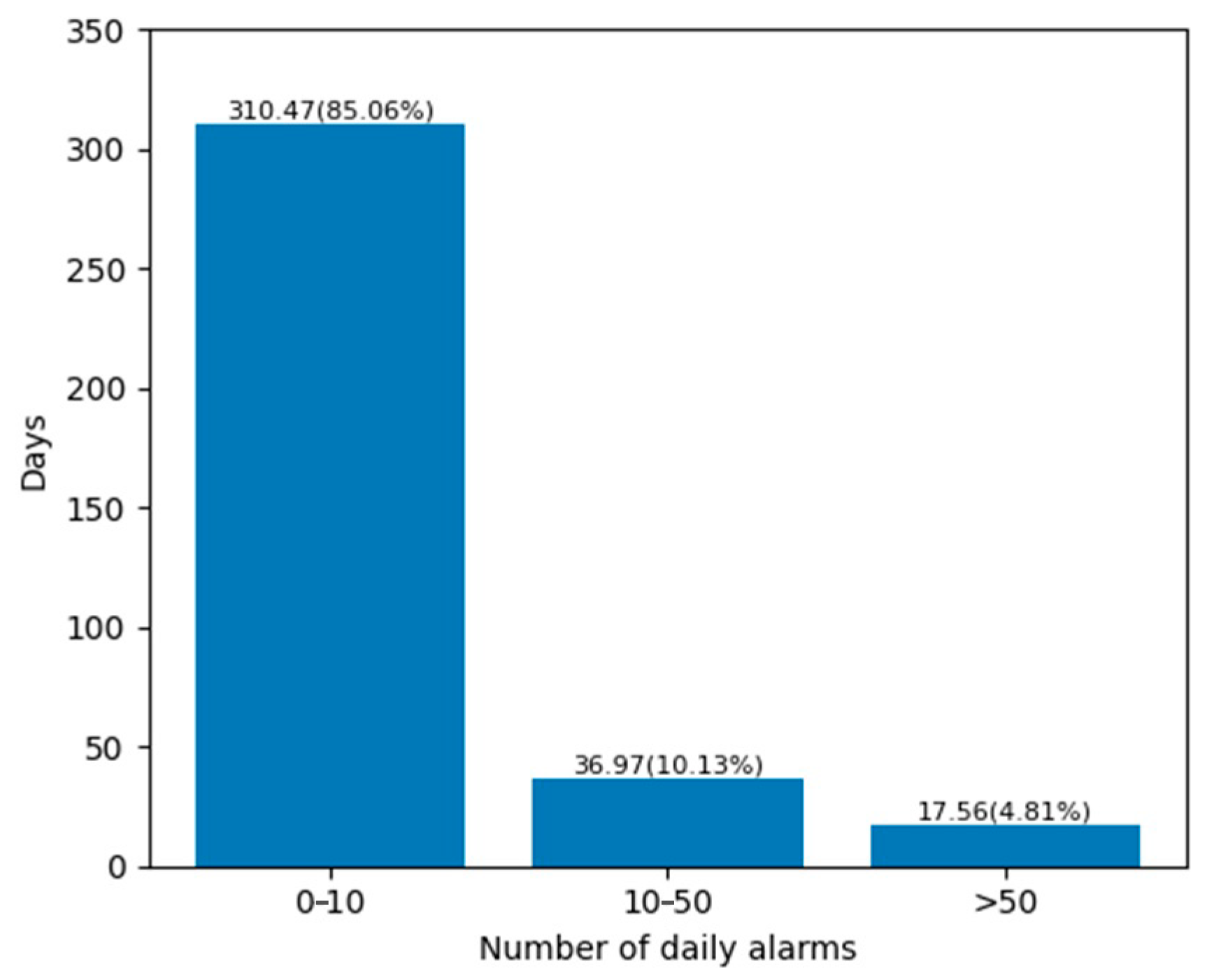

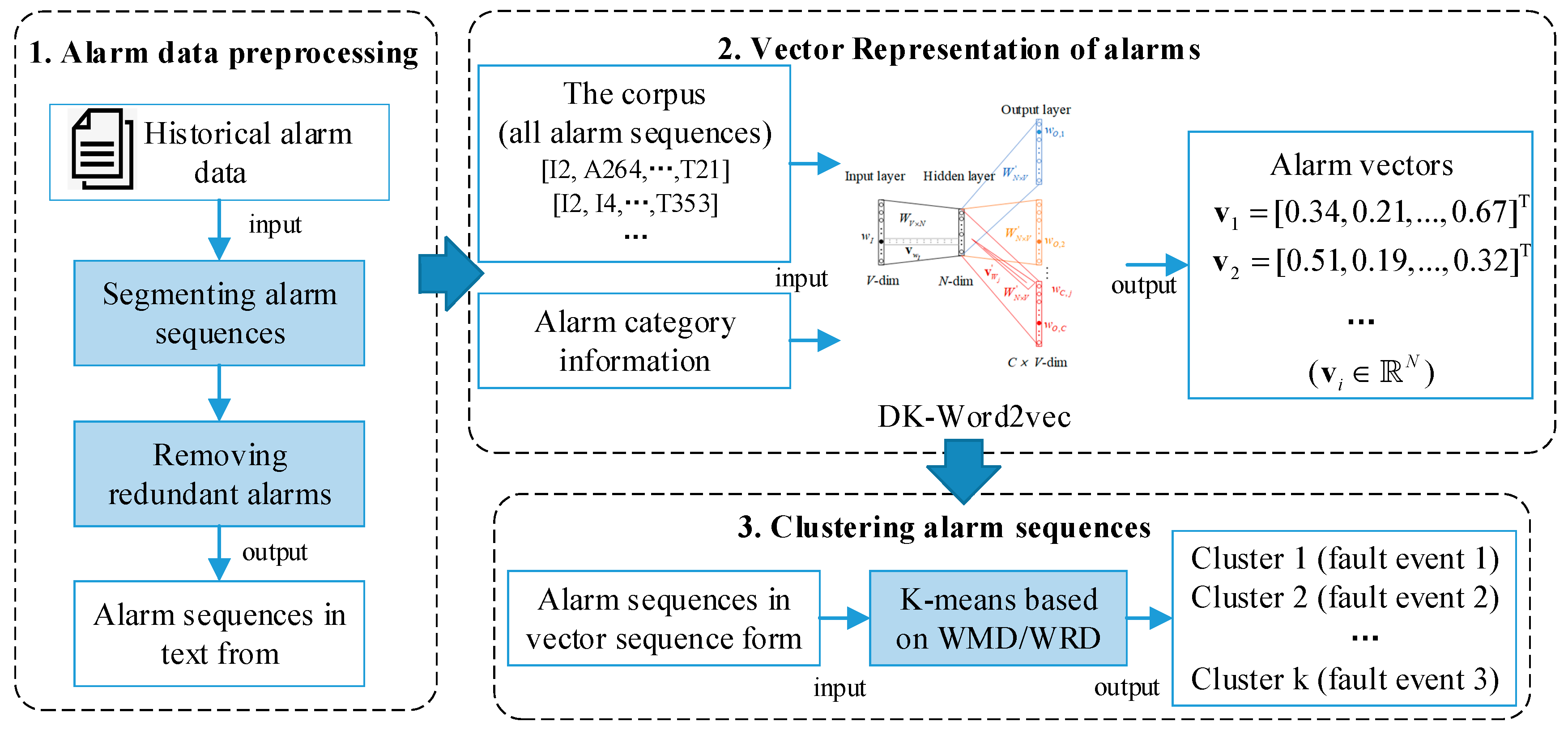
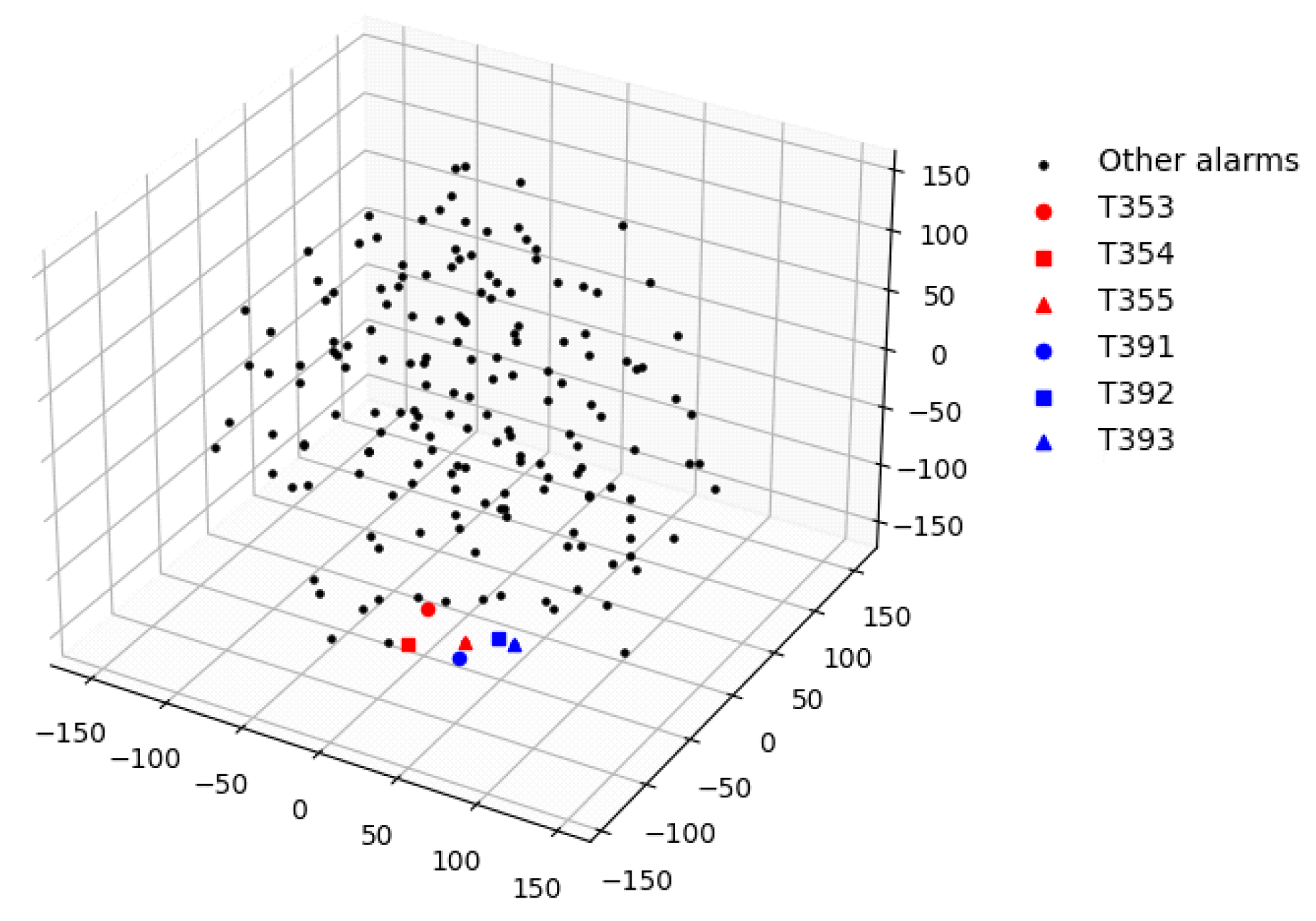

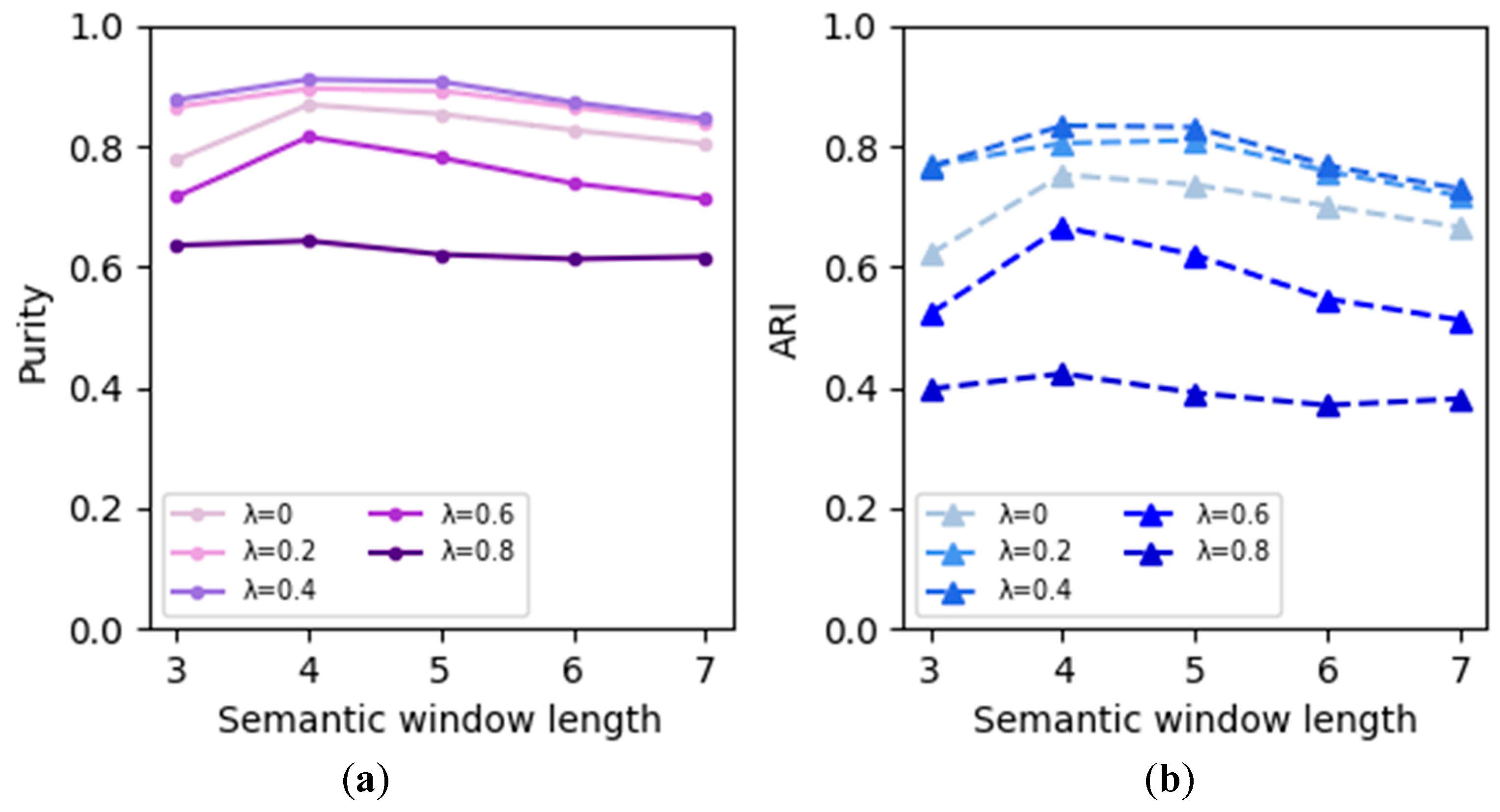

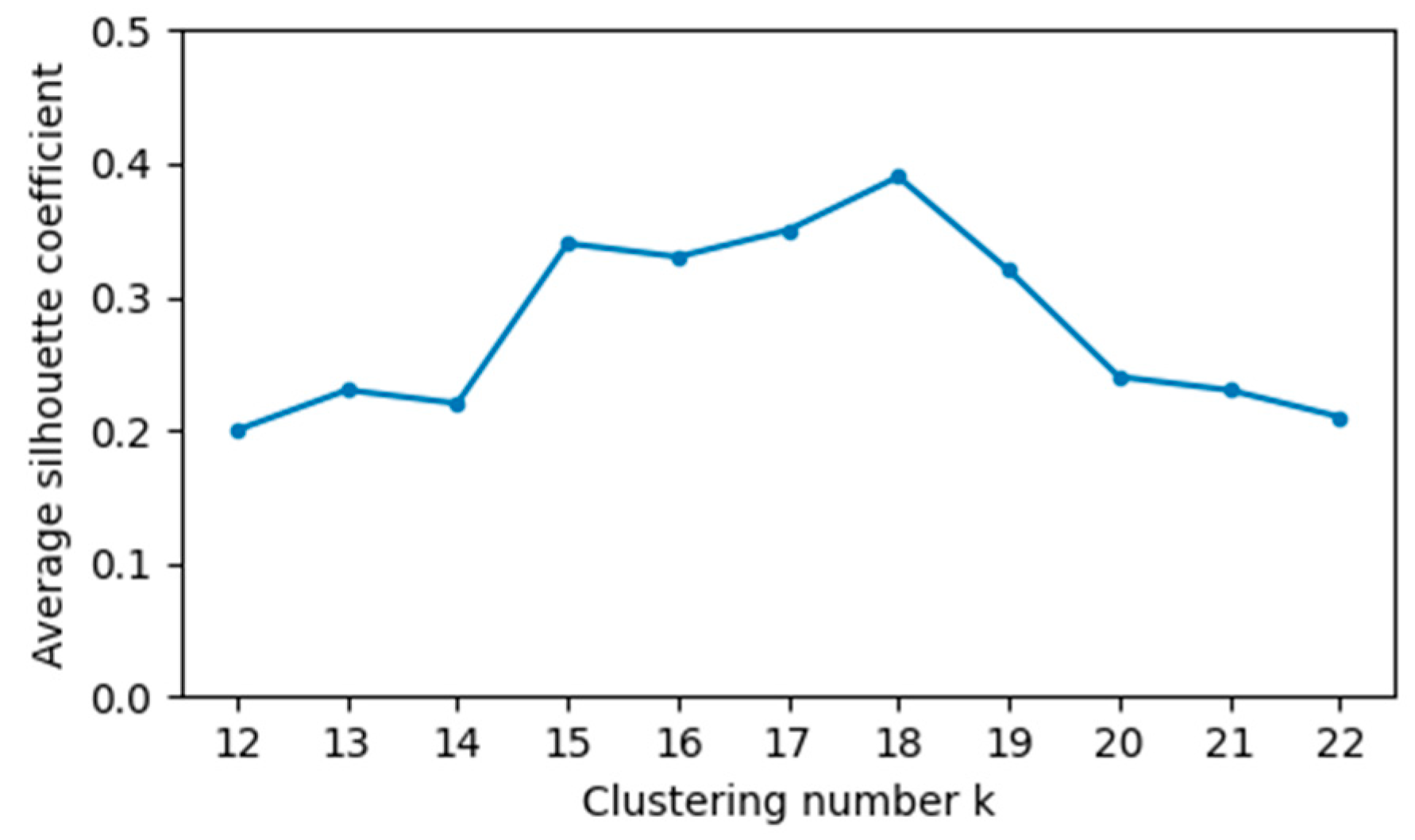

| Turbine Number | Triggering Time | Alarm Type | Alarm Code | Alarm Flag | Description |
|---|---|---|---|---|---|
| P02 | 22 December 2016 20:04:44 | Information | I2 | Start | The wind turbine is started |
| P02 | 22 December 2016 20:05:04 | Warning | A155 | Start | Low coolant pressure |
| P02 | 22 December 2016 20:05:08 | Warning | A155 | End | Low coolant pressure |
| P02 | 22 December 2016 20:05:19 | Fault | T110 | Start | The pressure differential of the coolant pump is too low |
| ID | Criteria | Categories |
|---|---|---|
| 1 | Alarm types | Information, warning, fault |
| 2 | Sub_assembles | Cooling, operational state, pitch, power supply, blades, generator, hub, tower, grid connection, frequency converter, sensor, system communication, main shaft, yaw, cabin, and others. |
| 3 | Failure mechanism | Temperature failure, voltage failure, current failure, and control failure. |
| 4 | Pitch actuator units | Actuator unit 1, actuator unit 2, and actuator unit 3. |
| Labels | Fault Events | Sample Numbers |
|---|---|---|
| 0 | Pitch system communication fault | 8 |
| 1 | Pitch system driver fault | 10 |
| 2 | Emergency pitching | 62 |
| 3 | Other faults of the pitch system | 17 |
| 4 | Frequency-converter communication fault | 14 |
| 5 | Other faults of the frequency converter | 15 |
| 6 | Generator faults | 11 |
| 7 | Yaw faults | 7 |
| 8 | Cabin faults | 8 |
| 9 | System communication faults | 6 |
| 10 | Sensor faults | 28 |
| 11 | Cooling system faults | 27 |
| 12 | Wind vane faults | 27 |
| 13 | Other faults | 21 |
| Turbine Number | Triggering Time | Alarm Types | Alarm Codes | Alarm Flags | Description |
|---|---|---|---|---|---|
| PX | 5 September 2016 15:43:29 | Information | I2 | Start | - |
| PX | 6 September 2016 05:12:23 | Information | I4 | Start | - |
| PX | 6 September 2016 05:12:27 | Information | I4 | End | - |
| PX | 9 September 2016 04:25:26 | Information | I200 | Start | - |
| PX | 9 September 2016 04:43:37 | Information | I200 | End | - |
| PX | 9 September 2016 20:52:36 | Information | I4 | Start | - |
| PX | 9 September 2016 20:52:40 | Information | I4 | Start | - |
| PX | 10 September 2016 07:52:58 | Fault | T21 | Start | - |
| PX | 10 September 2016 07:52:59 | Fault | T211 | Start | - |
| PX | 10 September 2016 07:53:00 | Warning | A155 | Start | - |
| PX | 10 September 2016 07:53:00 | Warning | A31 | End | - |
| PX | 10 September 2016 07:53:00 | Fault | T349 | Start | - |
| PX | 10 September 2016 07:53:00 | Fault | T319 | Start | - |
| PX | 10 September 2016 07:53:00 | Fault | T484 | Start | - |
| PX | 10 September 2016 07:53:01 | Fault | T43 | Start | - |
| PX | 10 September 2016 07:53:01 | Fault | T319 | End | - |
| PX | 10 September 2016 07:53:02 | Fault | T353 | Start | - |
| PX | 10 September 2016 07:53:02 | Fault | T354 | Start | - |
| PX | 10 September 2016 07:53:02 | Fault | T319 | Start | - |
| PX | 10 September 2016 07:53:02 | Fault | T355 | Start | - |
| PX | 10 September 2016 07:53:03 | Fault | T319 | End | - |
| PX | 10 September 2016 07:53:13 | Warning | A157 | Start | - |
| PX | 10 September 2016 07:53:13 | Fault | T319 | Start | - |
| PX | 10 September 2016 07:53:13 | Fault | T110 | Start | - |
| PX | 10 September 2016 07:53:17 | Fault | T353 | End | - |
| PX | 10 September 2016 07:53:17 | Fault | T392 | Start | - |
| PX | 10 September 2016 07:53:18 | Fault | T393 | Start | - |
| PX | 10 September 2016 07:53:21 | Fault | T354 | End | - |
| PX | 10 September 2016 07:53:23 | Fault | T391 | Start | - |
| PX | 10 September 2016 07:53:25 | Fault | T353 | Start | - |
| PX | 10 September 2016 07:53:26 | Information | I2 | End | - |
| The Numerical Representation Methods of Alarms | Purity | ARI |
|---|---|---|
| Binary vector | 0.629 | 0.394 |
| Binary vector and feature Extraction | 0.662 | 0.467 |
| Skip-gram model | 0.766 | 0.624 |
| DK-Word2vec | 0.831 | 0.729 |
Disclaimer/Publisher’s Note: The statements, opinions and data contained in all publications are solely those of the individual author(s) and contributor(s) and not of MDPI and/or the editor(s). MDPI and/or the editor(s) disclaim responsibility for any injury to people or property resulting from any ideas, methods, instructions or products referred to in the content. |
© 2023 by the authors. Licensee MDPI, Basel, Switzerland. This article is an open access article distributed under the terms and conditions of the Creative Commons Attribution (CC BY) license (https://creativecommons.org/licenses/by/4.0/).
Share and Cite
Wei, L.; Wang, L.; Liu, F.; Qian, Z. Clustering Analysis of Wind Turbine Alarm Sequences Based on Domain Knowledge-Fused Word2vec. Appl. Sci. 2023, 13, 10114. https://doi.org/10.3390/app131810114
Wei L, Wang L, Liu F, Qian Z. Clustering Analysis of Wind Turbine Alarm Sequences Based on Domain Knowledge-Fused Word2vec. Applied Sciences. 2023; 13(18):10114. https://doi.org/10.3390/app131810114
Chicago/Turabian StyleWei, Lu, Liliang Wang, Feng Liu, and Zheng Qian. 2023. "Clustering Analysis of Wind Turbine Alarm Sequences Based on Domain Knowledge-Fused Word2vec" Applied Sciences 13, no. 18: 10114. https://doi.org/10.3390/app131810114
APA StyleWei, L., Wang, L., Liu, F., & Qian, Z. (2023). Clustering Analysis of Wind Turbine Alarm Sequences Based on Domain Knowledge-Fused Word2vec. Applied Sciences, 13(18), 10114. https://doi.org/10.3390/app131810114





